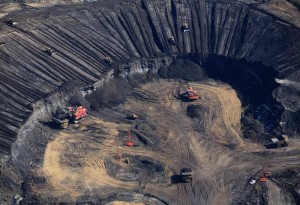
As they have toured Europe and America trying to promote the tar sands, Canadian and Albertan politicians have always touted that they are improving the environmental impact of their dirty product.
Part of improving the impact has been setting up a supposedly world-class monitoring programme.
For example in July last year, documents released in the UK under Freedom of Information reveal the extract of an email between Tony Kay the British Consul General in Calgary and Alison Redford, the Albertan Premier. Redford argued that a new “quasi-independent monitoring project would imminently publish a strategy for providing robust and scientific data.”
Could this be yet more empty promises, because the Canadian press is reporting that nearly a year after the Albertan and Federal government unveiled a three-year plan to increase the monitoring of the tar sands, there are still no formal public results.
The plan was meant to include monthly water testing. It was also meant to publicly produce data before the end of 2012.
But a year after the original plan was launched and weeks after the deadline, no data has been released. “We’re not yet at a stage where we can release the data and say ‘here is what we currently know’,” Karen Dodds, assistant deputy minister of Environment Canada’s science and technology branch told CBC Canada.
Dodds said some data might be produced by the end of the month, although “no date has been made final.”
The Canadians are still wrangling over money about who will pick up the bill. Although the industry has agreed to pay a maximum of $50 million a year for the monitoring, so far there is no governance structure to collect the money.
The respected Pembina Institute is now arguing that without the data being released further permits on tar sands development should not be released.
Meanwhile the need for detailed monitoring is laid bare by a memo published by Postmedia news, which reveals that tailings ponds from the tar sands are leaking and contaminating Alberta’s groundwater.
The memo, written for Canadian Natural Resources Minister Joe Oliver in June last year, warned that “studies have for the first time, detected harmful, mining-related organic acid contaminants in the groundwater outside a long-established out-of-pit tailings pond” .
The memo continued that “substantial levels of mining-related organic acids” were detected up to 1.6 km from a tailings pond.
The memo also reveals the “holding media lines” to take about releasing the information, one of which is that “this study is an example of the Government of Canada’s commitment to strengthening environmental review and protection”. Another would be releasing all monitoring data immediately.
And then comes the more difficult one about talking about tar sands disinvestment, rather than re-investment.

The Alberta Tar Sands first came to public awareness
about the same time as OPEC raised world (their) oil
prices for the first time. Canada then was aiming for
self sufficient petroleum. The fact that we are now selling this product is a direct result of those early attempts. Back then no one cared about environmental
issues. That has now changed. I suspect Canada will
soon bow to the pressures that have come about.
If only, there needs to be increased pressure on Canadians and our fascist government to shut this down. As long as our current government sits in power there will be no motion to change anything. Americans need to refuse dirty tar sands oil, the global community needs to ban ALL Canadian tar sands products, and threaten Canada with sanctions, until this is done. We Canadians need to over throw our fascist government, jail them all, They are criminals complicit in the destruction of our planet.